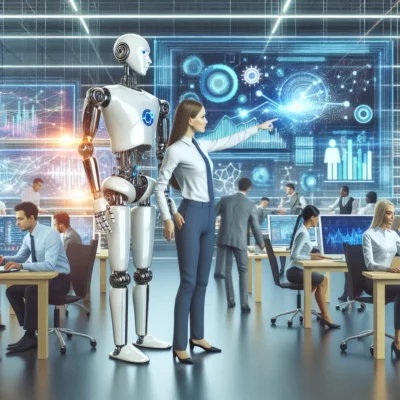The Rise of AI in the Workplace
Artificial Intelligence (AI) is no longer a futuristic concept but a present reality reshaping industries across the globe. From healthcare to finance, AI technologies are being adopted at an unprecedented rate, driving efficiency and innovation.
Overview of AI Technologies
- Machine Learning (ML): Algorithms that enable systems to learn from data and improve over time without explicit programming.
- Natural Language Processing (NLP): Enables machines to understand and respond to human language.
- Robotic Process Automation (RPA): Automates repetitive tasks, freeing up human workers for more complex activities.
- Computer Vision: Allows machines to interpret and make decisions based on visual data.
Statistics on AI Integration
- According to a report by McKinsey, 50% of companies have adopted AI in at least one business function.
- The global AI market is projected to grow from $58.3 billion in 2021 to $309.6 billion by 2026, as per MarketsandMarkets.
Leading Companies in AI Adoption
- Google: Utilizes AI for search algorithms, personalized recommendations, and autonomous driving.
- Amazon: Implements AI in logistics, customer service through chatbots, and personalized shopping experiences.
- IBM: Known for Watson, an AI system that applies advanced natural language processing and machine learning.
Redefining Job Roles
AI is not just automating tasks; it’s transforming job roles and creating new opportunities.
Automating Repetitive Tasks
AI excels at handling mundane and repetitive tasks, such as data entry, scheduling, and basic customer service inquiries. This automation allows human workers to focus on more strategic and creative tasks.
Emergence of New Job Roles
The rise of AI has led to the creation of new job roles centered around AI management and oversight, including:
- AI Ethicist: Ensures AI systems operate within ethical guidelines.
- Machine Learning Engineer: Designs and develops machine learning models.
- Data Scientist: Analyzes and interprets complex data to aid decision-making.
Case Studies
- Customer Service: Companies like H&M use AI chatbots to handle routine customer inquiries, allowing human agents to tackle more complex issues.
- Healthcare: AI-powered diagnostic tools assist doctors in identifying diseases, leading to more accurate and faster diagnoses.
Skillsets for the Future
As AI continues to evolve, so must the skillsets of the workforce.
Essential Skills
- Technical Skills: Proficiency in programming languages like Python, understanding of machine learning algorithms, and data analysis.
- Soft Skills: Critical thinking, problem-solving, and emotional intelligence will be crucial as humans collaborate more closely with AI.
- Adaptability: The ability to learn new tools and technologies quickly.
Continuous Learning and Adaptability
In an AI-driven workplace, continuous learning is vital. Employees must be willing to upskill and reskill to stay relevant. Online courses, workshops, and certifications can help bridge the knowledge gap.
Training and Development Programs
Organizations should invest in training programs to prepare their workforce for AI integration. Examples include:
- Coursera and Udacity: Offer specialized courses in AI and machine learning.
- Company-Sponsored Programs: Internal training sessions focused on AI tools and applications relevant to the business.
Enhancing Human-AI Collaboration
Effective collaboration between humans and AI can lead to unprecedented levels of productivity and innovation.
Strategies for Collaboration
- Clear Role Definition: Clearly define the roles of AI and human workers to ensure seamless collaboration.
- Feedback Loops: Establish mechanisms for continuous feedback to improve AI systems and human interactions.
Augmenting Human Capabilities
AI should be seen as a tool to augment human capabilities rather than replace them. For instance:
- Creative Industries: AI can generate design ideas, but the final creative decision rests with human designers.
- Healthcare: AI assists in diagnostics, but doctors make the final treatment decisions.
Real-World Examples
- Manufacturing: Companies like Siemens use AI to predict equipment failures, allowing human workers to perform maintenance proactively.
- Finance: AI algorithms assist financial analysts in identifying market trends, but strategic investment decisions are made by humans.
Ethical and Societal Considerations
The integration of AI raises important ethical and societal questions that must be addressed.
Job Displacement and Economic Inequality
While AI can create new job opportunities, it can also lead to job displacement. Policymakers and business leaders must work together to:
- Reskill Displaced Workers: Provide training programs to help workers transition to new roles.
- Promote Economic Inclusion: Ensure AI benefits are distributed fairly across society.
Ethical AI Practices
Transparency and ethical practices are crucial for gaining public trust in AI systems. This includes:
- Bias Mitigation: Implementing measures to prevent and address biases in AI algorithms.
- Data Privacy: Ensuring that AI systems comply with data protection regulations.
Policies and Regulations
Governments and regulatory bodies must establish policies to ensure fair AI implementation. This includes:
- AI Governance Frameworks: Guidelines for ethical AI development and deployment.
- Labor Laws: Updating labor laws to protect workers in an AI-driven economy.
Preparing Organizations for the AI Era
To thrive in the AI era, organizations must take proactive steps to integrate AI into their operations.
Integration Steps
- Assess Readiness: Evaluate the current state of AI readiness within the organization.
- Develop a Strategy: Create a comprehensive AI strategy aligned with business goals.
- Invest in Technology: Invest in the necessary AI technologies and infrastructure.
Change Management Strategies
Effective change management is crucial for successful AI integration. This includes:
- Communication: Clearly communicate the benefits and impact of AI to employees.
- Training: Provide training programs to help employees adapt to new technologies.
- Support Systems: Establish support systems to assist employees during the transition.
Role of Leadership
Leadership plays a pivotal role in driving AI adoption. Leaders must:
- Champion Innovation: Foster a culture of innovation and continuous improvement.
- Lead by Example: Demonstrate a commitment to AI integration through their actions.
- Empower Employees: Empower employees to experiment with AI and contribute to its implementation.
AI is revolutionizing the workplace, transforming job roles, and reshaping workforce dynamics. By embracing AI and preparing for its impact, organizations can unlock new opportunities for growth and innovation.
